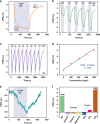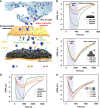Moisture-resistant, stretchable NOx gas sensors based on laser-induced graphene for environmental monitoring and breath analysis
- PMID: 35818382
- PMCID: PMC9270215
- DOI: 10.1038/s41378-022-00414-x
Moisture-resistant, stretchable NOx gas sensors based on laser-induced graphene for environmental monitoring and breath analysis
Abstract
The accurate, continuous analysis of healthcare-relevant gases such as nitrogen oxides (NOx) in a humid environment remains elusive for low-cost, stretchable gas sensing devices. This study presents the design and demonstration of a moisture-resistant, stretchable NOx gas sensor based on laser-induced graphene (LIG). Sandwiched between a soft elastomeric substrate and a moisture-resistant semipermeable encapsulant, the LIG sensing and electrode layer is first optimized by tuning laser processing parameters such as power, image density, and defocus distance. The gas sensor, using a needlelike LIG prepared with optimal laser processing parameters, exhibits a large response of 4.18‰ ppm-1 to NO and 6.66‰ ppm-1 to NO2, an ultralow detection limit of 8.3 ppb to NO and 4.0 ppb to NO2, fast response/recovery, and excellent selectivity. The design of a stretchable serpentine structure in the LIG electrode and strain isolation from the stiff island allows the gas sensor to be stretched by 30%. Combined with a moisture-resistant property against a relative humidity of 90%, the reported gas sensor has further been demonstrated to monitor the personal local environment during different times of the day and analyze human breath samples to classify patients with respiratory diseases from healthy volunteers. Moisture-resistant, stretchable NOx gas sensors can expand the capability of wearable devices to detect biomarkers from humans and exposed environments for early disease diagnostics.
Keywords: Electronic properties and materials; Environmental, health and safety issues.
© The Author(s) 2022.
Conflict of interest statement
Conflict of interestThe authors declare no competing interests.
Figures







Similar articles
-
Intrinsically Breathable and Flexible NO2 Gas Sensors Produced by Laser Direct Writing of Self-Assembled Block Copolymers.ACS Appl Mater Interfaces. 2022 Apr 20;14(15):17818-17825. doi: 10.1021/acsami.2c02061. Epub 2022 Apr 8. ACS Appl Mater Interfaces. 2022. PMID: 35394746
-
Laser-Induced Graphene Stretchable Strain Sensor with Vertical and Parallel Patterns.Micromachines (Basel). 2022 Jul 29;13(8):1220. doi: 10.3390/mi13081220. Micromachines (Basel). 2022. PMID: 36014142 Free PMC article.
-
Fully Stretchable and Humidity-Resistant Quantum Dot Gas Sensors.ACS Sens. 2018 May 25;3(5):1048-1055. doi: 10.1021/acssensors.8b00263. Epub 2018 May 15. ACS Sens. 2018. PMID: 29737152
-
Physical and Chemical Sensors on the Basis of Laser-Induced Graphene: Mechanisms, Applications, and Perspectives.ACS Nano. 2021 Dec 28;15(12):18708-18741. doi: 10.1021/acsnano.1c05806. Epub 2021 Dec 9. ACS Nano. 2021. PMID: 34881870 Review.
-
Laser-induced graphene (LIG)-driven medical sensors for health monitoring and diseases diagnosis.Mikrochim Acta. 2022 Jan 10;189(2):54. doi: 10.1007/s00604-021-05157-6. Mikrochim Acta. 2022. PMID: 35001163 Free PMC article. Review.
Cited by
-
Advancing Frontiers: Graphene-Based Nano-biosensor Platforms for Cutting-Edge Research and Future Innovations.Indian J Microbiol. 2025 Mar;65(1):453-476. doi: 10.1007/s12088-024-01318-2. Epub 2024 Jul 6. Indian J Microbiol. 2025. PMID: 40371023
-
Room-Temperature Ammonia Sensing Using Polyaniline-Coated Laser-Induced Graphene.Sensors (Basel). 2024 Dec 7;24(23):7832. doi: 10.3390/s24237832. Sensors (Basel). 2024. PMID: 39686369 Free PMC article.
-
Multiplexed DNA-functionalized graphene sensor with artificial intelligence-based discrimination performance for analyzing chemical vapor compositions.Microsyst Nanoeng. 2023 Mar 20;9:28. doi: 10.1038/s41378-023-00499-y. eCollection 2023. Microsyst Nanoeng. 2023. PMID: 36949735 Free PMC article.
-
Rationalizing Graphene-ZnO Composites for Gas Sensing via Functionalization with Amines.Nanomaterials (Basel). 2024 Apr 23;14(9):735. doi: 10.3390/nano14090735. Nanomaterials (Basel). 2024. PMID: 38727329 Free PMC article.
-
Vanadium Oxide-Doped Laser-Induced Graphene Multi-Parameter Sensor to Decouple Soil Nitrogen Loss and Temperature.Adv Mater. 2023 Apr;35(14):e2210322. doi: 10.1002/adma.202210322. Epub 2023 Mar 1. Adv Mater. 2023. PMID: 36656071 Free PMC article.
References
-
- Ye C, Ume CI, Sitaraman SK. Mechanical characterization of embedded serpentine conductors in wearable electronics. J. Electron Packaging. 2020;142:021007. doi: 10.1115/1.4046163. - DOI
-
- Aaryashree, et al. Recent developments in self-powered smart chemical sensors for wearable electronics. Nano Res. 2021;14:3669–3689. doi: 10.1007/s12274-021-3330-8. - DOI
-
- Zhai W, et al. Ultra-stretchable and multifunctional wearable electronics for superior electromagnetic interference shielding, electrical therapy and biomotion monitoring. J. Mater. Chem. A. 2021;9:7238–7247. doi: 10.1039/D0TA10991F. - DOI
LinkOut - more resources
Full Text Sources
